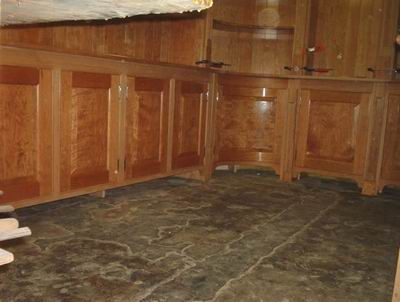Question
I used to install for a stair builder who refused to include any wear protection in his installations. He didn't want to be liable for any failure of the provided protection.
We do protect our work, but I'm looking for ways to improve our methods. My preferred method at present is to carefully wrap and seal treads with rip resistant paper (not red rosin) and fasten masonite or homasote over that. Leading edges of treads are difficult to protect. Our treads always have either a seal coat of de-waxed shellac or a full conversion varnish finish.
Assuming the other elements of the stair are paint grade, we leave the protection to the GC. I'd like to hear other strategies.
Forum Responses
(Architectural Woodworking Forum)
From contributor J:
I think quite a lot of finish stairs are just overlayments of rough stairs, so the question doesn't always come up.
One company I'm familiar with uses their own specially fabricated tread/riser cardboard covers which usually stay in place until all job-site construction is complete. These are all set and taped in place in the factory prior to shipment.
I have gone so far as to make complete sets of rough plywood treads and risers to cover (as much as possible) the finish stair. These treads and risers are nailed or screwed together in any convenient fashion with the risers floating off the finish risers and nosings.
I usually charge extra for this kind of "Construction Barrier Overlayment," but it is the only way to really protect the finish stair. Various kinds of paper or self-adhesive sheet plastic are also in place underneath the rough plywood.
The best solution, however, is the availability and use of a back stair, with the finish stair strictly off limits. "Keep off the stair" is clearly posted (both at the top and bottom) along with a barrier fence and "do not cross" tape.
After all you can do, however, you still need to make it clear to the customer that the finish stair (after delivery and setup) belongs to him and is therefore his responsibility. Your responsibility is to deliver and/or install an unmarred or undamaged product and obtain a signature confirmation.
One of the biggest issues is having grit get underneath the protective ply and having that slip and slide around. A few carefully placed finish nails up into the bottom of the nosing? We have finish-nailed taped homasote treads/pads directly on top of the protective paper covering believing that a couple nail holes in the finished tread are preferable to having the protective covering fail.
I'd be very happy to pass all of this on to the GC, but being a shop fabricator of stairs, it can occasionally affect the choice made between shop or site built stairs (site installed treads can be installed later in the job).
A fine finish overlayment of a rough framed stair (slammed together by a construction carpenter with a hammer/hatchet) was never a good idea. It is, however, the way it often is. I don't have to like it though, and I'm plenty tired of trying to convince potential customers that it's in their best interest to tear the rough stair out (this usually goes over like a lead balloon).
Last month I had to tell a lady that I absolutely could not cover her existing rough stair. All the treads and risers were cut from construction 2x12s (which were all wet and warped) and the last tread at the very top of a straight flight stair was only 9.5" deep! That left a full 15 treads at 11.5" to fall down on. She'd already had several estimates and I was the only "stair guy" with any objections. I didn't want the job anyway, but that's what we're up against.
I like to cover both the finish treads and risers with MDF and actually nail them down here and there.
